Football LED Stadium Lights Buyer’s Guide 2019
Football LED Stadium Lights Buyer’s Guide 2019
What is the best stadium lights? Why doing LED replacement for metal halide, halogen, HPS and mercury lamps? What factors should we consider before buying the football field lights? This article will give you a brief idea on how to light up the outdoor ball field having FIFA World Cup, Olympic Games, Premier League and UEFA standards with LED.
It is exciting to start preparing the documentation and products for the lighting tender. To increase the chance of success, the first and foremost tips we need to consider is the requirement of the lighting fixtures, including the lux (brightness), and uniformity.
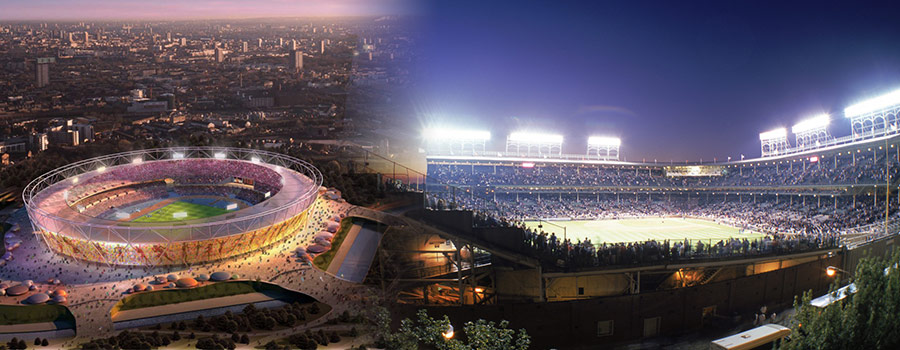
There are many regulations regarding to stadium lighting. According to lighting guide of UEFA, there are six types of football field. Elite Level A for Europa League finals, Level A for Super Cup final, Level B for semi-final matches, Level C for qualifying round and so on. The lighting standard increases with the importance and popularity of the matches, says we have the highest standard for final.
1. Brightness of Football Field
The lighting is divided into two parts including horizontal and vertical luminance. Horizontal means the light cover the ball field, while vertical is for the portrait of players. The document states that the lighting for stadium should have 2000 lux for horizontal and 1500 lux for vertical. For this setting, we will need hundred sets of high power LED flood lights.
2. Lighting Uniformity
UEFA also requests the stadium lighting to have 0.5 to 0.7 uniformity. This parameter is based on a 0-to-1 scale indicating the extent of uniform distribution of the luminance. it is an important consideration because uneven lights will irritate the player’s and audiences’ eyes. In fact, it is not any easy task to accomplish the high uniformity as we can imagine that the light spot is circular (or often rectangular), there will be overlapping and the areas that do not have overlap. One of the techniques we adopt is using the LED lights having smaller beam angle and smaller power. The asymmetric design can improve the lighting distribution. We provide LED lights for the international matches such as Premier League and Olympic Games.
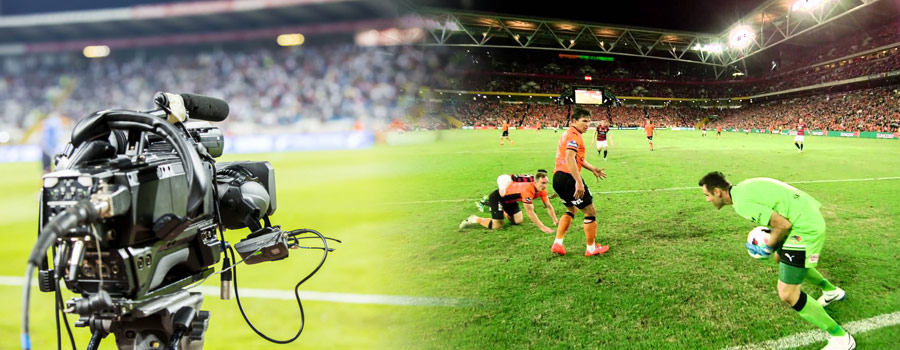
3. TV Broadcasting Compatibility
Now is the new era of 4K TV broadcasting. Uniform and quality vertical luminance on LED floodlights allow high standard photo and video capture production. Therefore, we put much effort to reduce the glare of luminaires as well. The anti-glare optics in our LED lights do not produce flickering and dazzling feeling on players and audiences. This technique is achieved by special lens cover and coating that maintains the brightness while suppressing the unwanted glare.
4. Height of Stadium Roof
The height of the luminaries is usually fall within 30 to 50 meters; therefore, we need the good LED lighting that does not have too much loss of luminance. Indeed, the light loss is sometimes inevitable for nowadays technology because no matter how precise you have the photometric design, not all 100% light beam is projected to the football field. Instead, part of the lumen (around 30%) is scattered to the surrounding. To solve this issue, we have two ways.
a) Using Better Optics
Adopting the high-quality LED chips & lens cover reduce the loss of brightness because the light beam is more concentrated; however, the limitation is that we cannot use these lights for the entire football pitch because the uniformity will be decreased – imagine there are countless circular spots on the ground. Hence, it is necessary to achieve a good balance by having a comprehensive photometric design. Our engineers are eager to help. You can always get the prompt response by filling in our form.
b) Increasing the Number of Lighting Fixtures Used
It is a relatively passive way to install more flood lights onto the stadium ceiling to against the lumen depreciation. For instance, if the theoretically (calculated) value is 10000 watts, we will need at least 12000 to 13000 watts eventually to have the best outcome.
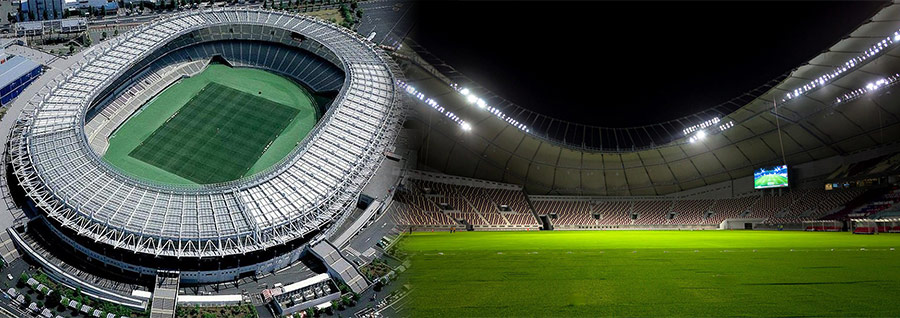
5. Power of LED Lights Required
To have a quick idea on the total power needed for the football stadium lights. We can have the following calculation. Take a traditional 105 m * 68 m football field as an example. The 7140 meter-square turf requires 7140 * 2000 lux = 14,280,000 lumens. What does it mean? Since our stadium floodlight has luminous efficiency of 140 lm/W, the minimum wattage of LED should be 14,280,000 / 140 = 102,000 watts. It is the theoretical minimum value we needed, as we also need to take the light loss and the height of luminaires into account as mentioned above. Before doing the computer lighting simulation, we will know that the power required is about 150,000 watts. Isn’t it incredible?
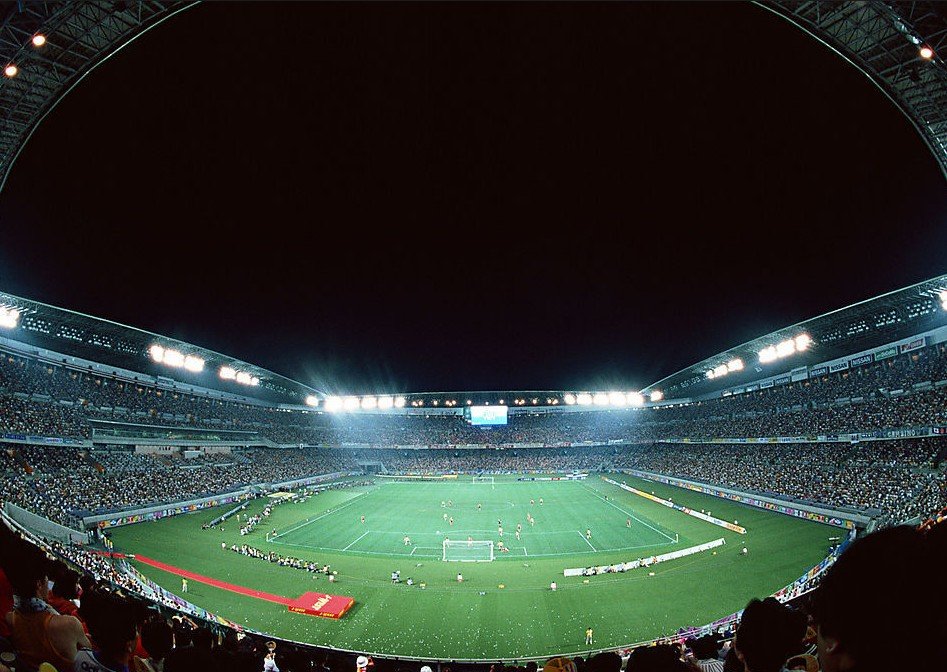
At this point, you may ask what would be my situation if I currently use metal halide lamps to light football stadium? This answer is doubling the power required! Since the lighting efficiency of metal halide is about 70 lm/W, the power required is about 300,000 watts. Therefore, having the metal halide replacement for stadium lights can save much energy and thus the electricity bill.
6. Stadium Light Pollution Problem
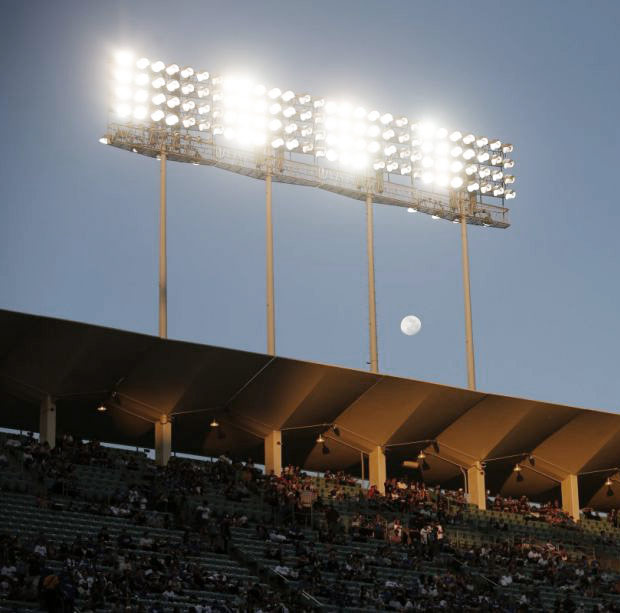
Top lighting for stadiums must not lead to light pollution. As the light leakage significantly affect the neighboring residential areas. In 2017, there is a repetition related to this issue in Michigan, US. The NFL stadium in Detroit uses very high-power lighting. However, there is considerable amount of light scattering outside the venue. Some even complained that the light is irritating and greatly affecting the sleep when the house is 5 km away from the arena. The safety of road users is also negatively impacted.
In fact, the ground brightness surrounding the arena should not exceed 25 to 30 lux. It has become one of the lighting requirements.
Metal Halide Replacement for Stadium Lights
About 45% of football stadiums in US still uses traditional light source such as metal halide, HPS and HID lamps. Although the efficiency of MH lamps is improving from time to time, it is still significantly less than LED lights. Nowadays, the efficiency of LED has raised to 140 lm/W while MH is about 75 lm/W. Apart from lights for new arena, we also supply high quality LED for metal halide replacement of football stadium lights.
7. Longer Life Span
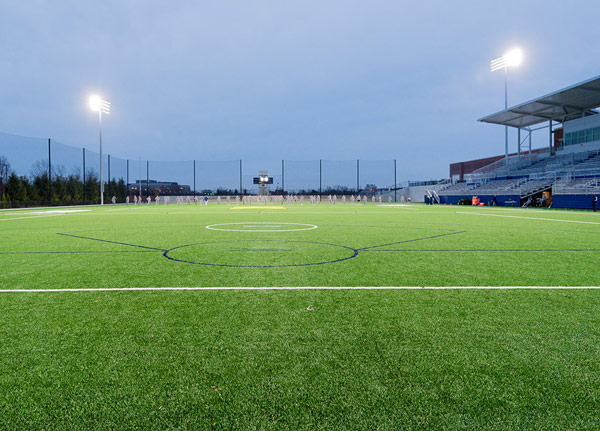
By retrofitting metal halide to LED lights, the life span of the luminaires is greatly increased to 80,000 hours. If you turn on the lights for 8 hours per day, our products can last for at least 25 years without significantly decline on brightness. LED is also regarded as a durable light because of its solid-state properties. Our modified lighting products do not contain the delicate components such as surface soldering and gold wire.
8. Good Heat Dissipation System
Another reason for high durability is that our LED lights for football fields have a very good heat dissipation system. As a matter of fact, if the heat continuously accumulates around the LED chips, the brightness and life span will be decreased; and thus, we also attach foremost importance in improving the heat sink that reduce the junction temperature of lights for long-term operation. Generally, it is achieved by large and circular arranged aluminum extension fins which contain large surface areas.
9. Durability of Floodlights
After the metal halide replacement for stadium lighting, we can have a stronger material for the luminaries. It is because our LED lights are made of polycarbonate and quality aluminum alloy. The material is anti-corrosive, so it is very unlikely to be damaged for normal use. Besides, our products have IP66 waterproof certification. It can tolerate rainstorm and general water splash.
10. Warranty
According to our experience, the LED companies usually give 1 to 5-year warranty. Why not selecting the one that has longer guarantee period, and thus you can always obtain the quick support from the company.
Customized Stadium Lighting Design
A good lighting design unleashes the full potential of the LED stadium lights. Our engineers consider the projects on case-by-case basis, such as lux & uniformity requirement, pole height, weight tolerance and etc.
Step 1: Understand Your Football Stadium
First and foremost, the layout of the sports field and high mast poles are acquired. We will draw the 3D models to simulate the actual outdoor environment. The more information we get, the more accurate lighting plan we can deliver.
It is very common for the field to have 4-pole, 6-pole, or round roof arrangement. The height of mast is up to 30 to 50 meters. The LED lights are mounted to the corresponding 3D light poles.
Step 2: Selection of Stadium Flood Lights
It takes hundreds of sets of high power flood lamp to provide adequate brightness for Premier League, Olympic Games or other professional football fields.
We cannot use the same setting in different projects because the pole height, lux requirement, horizontal distance between the ball field and pole, and other parameters are unique. Our engineers will select the best power and beam angle combination of the LED lights.
Step 3: Orientation of Luminaries
After the selection of proper power and beam angle, we will rotate the lights inside the software to further improve the ground lighting uniformity. The projection angle of each luminary is finely adjusted to optimize their brightness and uniformity. Contact us for this premium service today.
Step 4: DIALux Photometric Report
After the complicated work, the results are outputted as a DIALux file, which consists of false color rendering, isolines and value chart.
Stadium Lighting Questions & Answers
1. What is the Difference Between Flood Lights & Stadium Lamp?
Floodlight is the luminary that emits broad and bright artificial lighting. It can be applied to almost all kinds of sports fields. Flood lights describe the general type of lighting. However, when it comes to lighting up the gigantic stadium, the flood lamp would have the special design.
First, the optics is re-designed for long distance transmission of lights. The idea is that we need to keep the lights flooding the football field in a wide beam angle, while reduce the light scattering that leads to light pollution.
Second, our stadium lighting fixtures adopted the advanced aerodynamic design that reduces the air resistance. Our LED lights have open structural design that improves air ventilation. The feature is essential for the lights mounted to high mast pole.
Moreover, light-weight luminaires are preferred because sometime we might need to mount up to 20 to 40 flood lights to the pole. If the lights are heavy, we might need to reinforce the pole. The cost is even comparable to the lights themselves! We adopt high-quality aluminum alloy that is strong but light-weight.
2. How to Differentiate Between Flood Lights & Spot Lights?
The major difference between spotlight and flood light is their beam angle. Spotlight has the smaller beam angle of 25° to 50° while flood lights have over 100° to 120°. As we can see from the above picture, the illumination area of floodlights is larger than that of spotlighting.
They have different application in the sports field. As mentioned, flood lights can light up large space like the turf. What is the application of spotlight? It can be applied as the decorative lighting. RGB color-changing spotlight can be installed to the stadium ceiling. We can have a very narrow beam angle of 5° to 10° of colored lights during break. It provides bewitching lighting effect.
3. How Many Watts Do We Need to Light Up a Stadium?
To light up the whole football stadium, it takes approx. 40,000 watt to 200,000 watt flood lights. The actual required wattage depends on the stadium’s lighting requirement, scale, ceiling height, pole height and type of lights. For a sports field requiring 1000 lux or 3000 lux level would result in a completely different total power consumption.
If you are using metal halide, halogen or HPS lamp having 2000 watt per fixture, the power consumption can be cut into half or more by switching to LED lights. Says, a 500W to 1000W LED generates the more-or-less the same brightness as such the HID lighting. The advantage is that the running cost of lighting is reduced. It is because the total wattage is reduced.
4. What are the Lumens of Football Field Lights?
Lumen indicates the output brightness of a flood light. When doing the metal halide LED replacement, we can compare the lumens of the existing & new lights. The table below summaries the lumens of stadium floodlights.
| Power of Stadium Lamps | Lumens | Metal Halide Equivalent |
| 500W | 70,000 lm | 1000 to 2000W |
| 800W | 112,000 lm | 1600 to 2500W |
| 1000W | 140,000 lm | 2000 to 3500W |
| 1500W | 210,000 lm | 3000 to 5000W |
| 4000W | 560,000 lm | 6000 to 10,000W |
Since the luminous efficacy of our LED lights is 140 lm/W, the lumens of a 1000W stadium lights = 1000W x 140 lm/W = 140,000 lumens. Depending on the types & brands of the metal halide lights, the 4000W LED can replace up to 10000W metal halide lights because they have comparable lumen output.
Conclusion
Hence, our high-power LED stadium floodlights are compatible to the professional requirement imposed by FIFA World Cup, Olympic Games, and Premier League matches. Our self-developed Premium Optics guarantees super bright & no-shadow illumination (4K broadcasting supported), as well as the exceptional ground reach ability of light beam. The anti-glare technology reduces the impact on the players & spectators. We understand the lighting requirement as we completed several Premier League projects with very good compliance.




